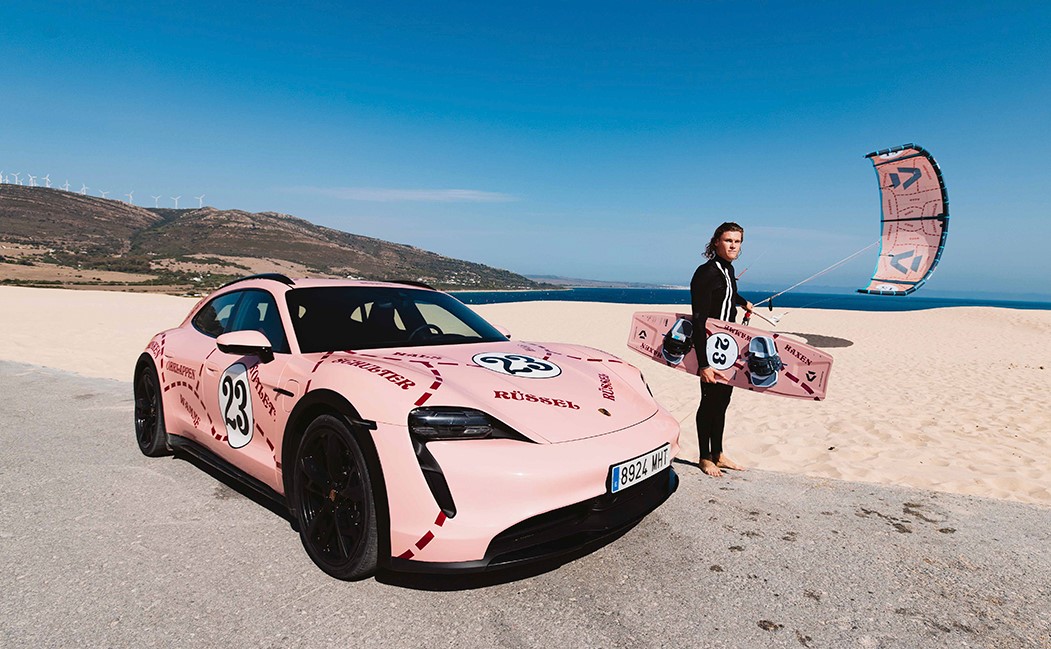The headline is not entirely true, but it is not a lie either. If you think about a car, you have failed, but if we explain that the quintessential German sports car manufacturer has created a kitesurfing kite with its essential board, things start to add up.
Porsche has not moved into the water sports sector, but in 2022 it began a design collaboration with the most renowned manufacturer of competitive kites and kitesurf boards in the world, the Italian firm Duotone. That first Duotone Porsche kite sold out almost immediately, and at the end of 2023, taking advantage of the fact that kitesurfing is included in the Olympic sailing sports program during the Paris 2024 Olympic Games, it was presented on Valdevaqueros beach, one of the best kitesurfing destinations in the world, just a few kilometers from Tarifa, an evolution of that first model.
The new kites and boards were presented with a demonstration on the sea carried out by a team of professional kitesurfers, led by the Spaniards Liam Whaley (born in Ibiza, although with an English father and a Dutch mother) and Rita Arnaus, two of the main representatives of the freestyle kitesurfing category.
The curious thing is that the design of the new kites and boards is inspired by the surprising design of one of the most famous racing cars in Porsche history: the 917/20, which was called “Pink Pig.” pink). A little history
The Porsche 917 was a sports racing prototype developed by Porsche to take advantage of the regulations relating to the construction of sports cars with five-liter engines, with which it came to dominate sports car racing in 1970 and 1971. With that model Porsche obtained its first victory in the 24 Hours of Le Mans in 1970, a feat that it would repeat in 1971. It would be mainly responsible for Porsche winning the International Brands Championship in 1970 and 1971.
For the 1971 24 Hours of Le Mans, Porsche engineers, in collaboration with French aerodynamic engineer Robert Choulet, who worked for the French company Société d’Études et de Réalisations Automobiles (SERA-CD), attempted to develop a unique experimental car. , which would combine the characteristics of two previous models, the low aerodynamic drag of the Langheck and the stability of the Kurz. The Porsche designer, the Latvian Anatole Lapine, presented a design that was disdained by the French, but to make amends to his employee, Porsche managers allowed him to design the external appearance of the car. For Lapine, the body developed by Choulet, extremely wide and with very rounded wheel cuts, said that it reminded him of a pig, and to ridicule him he completed the work by painting the car with pink paint, simulating the drawing of the cuts used by the butchers to cut up a pig. Hence his popular nickname in English [in German they called him “Sau”: pig].
The “Pink Pig” only raced that one time, with the Martini International team and driven by Reinhold Joest and Willi Kauhsen. He won the qualifying session despite not being tested at all and in the race he ran in third position, but retired from the race after an accident caused by brake failure while driving Joest.
360 units of ribs, knuckle, loin, jowl…
However, his striking appearance made no one forget him. To the point that, more than fifty years later, Porsche, with the approval of Duotone, decided to recover its memory with that casual design for the creation of this new foray into the field of kite and kite-surf board design, including the names of the parts of the pig: “Lende”, “Rückenspeck”, “Haxen”, “Wamme”, “Schulter”, “Hals”, “Hirn”, “Schwanz”, “Ohrlappen” or “Rippe”, [“ loin”, “back fat”, “knuckles”, “jowl”, “shoulder”, “neck”, “brains”, “tail”, “ear” and “rib”]. As Florian Panther, designer and creative director of Duotone, explains: “Today, we are in contact with a huge variety of different designs, colors and shapes in architecture, product design and fashion. But in the 70s, racing cars often had a sponsored livery: Martini and Gulf Racing are probably the most famous examples. And then Porsche arrived with this crazy, out-of-the-ordinary design that had never been seen before on a circuit.”
Accompanying the kites and boards, Porsche was not present in Valdevaqueros with the mythical “Pink Pig”, which is kept safe in the Porsche Museum in Zuffenhausen, the Stuttgart neighborhood where the Porsche factory is also located.
Instead, the car that we could see, screen printed as if it were that mythical 917/20, was a special version of its Taycan electric model, to give us an idea of what that car could look like on the Le Mans circuit.
“There is no general judgment on good design,” Panther continues explaining about the choice of the look of this special edition. Personal opinion and subjective impressions play a very important role. But when something is created that becomes an iconic design, it is not produced without reason. It’s a good design, whether you like it or not. And this is, without a doubt, an iconic design. “I like it because it is daring, but also because it is the result of chance.”
What is not the result of chance is the number of units of kites and boards that have gone on sale, 360, a number that refers to the maximum speed reached by the famous original “Pink Pig”, 360 km/h…
